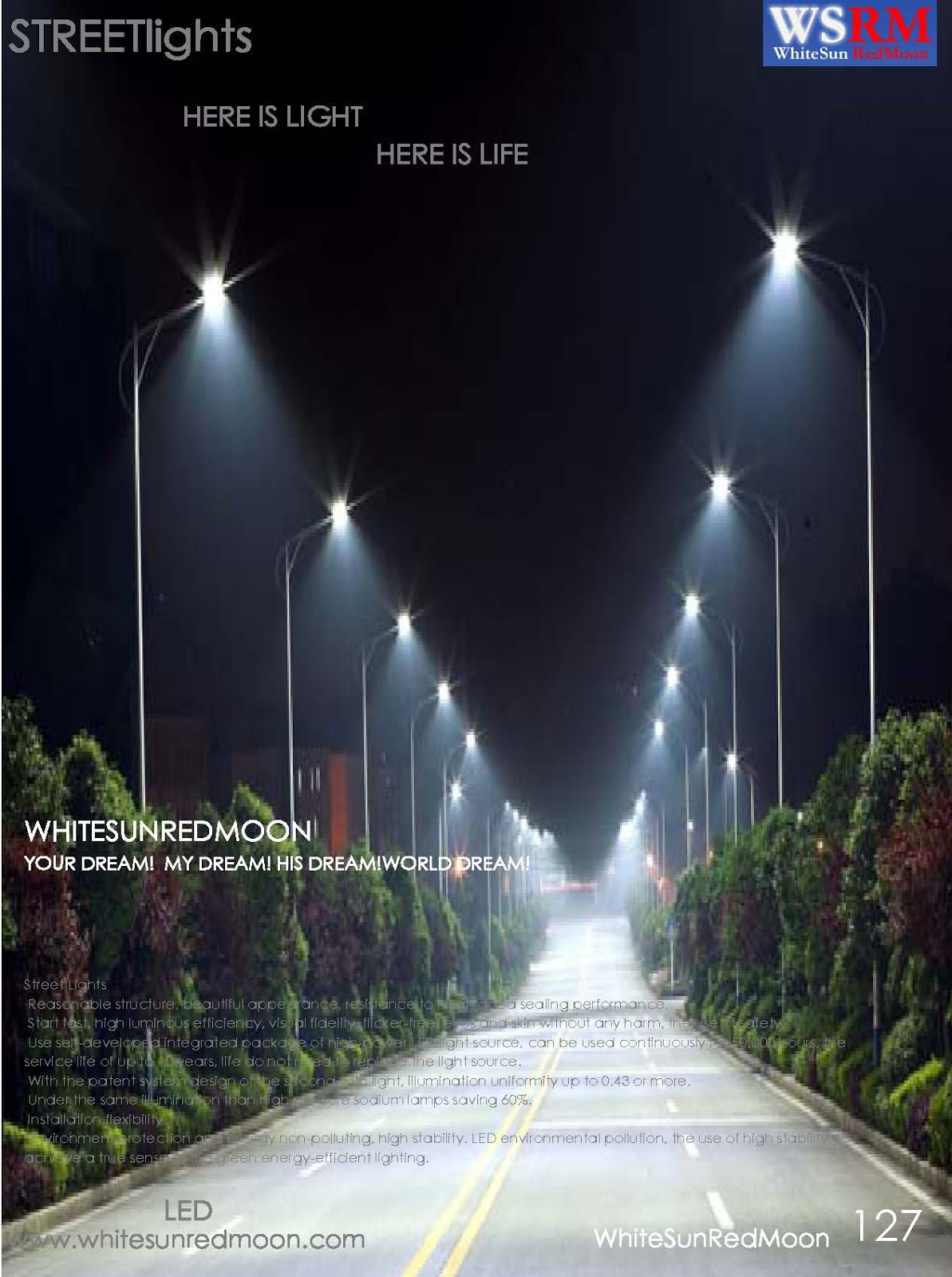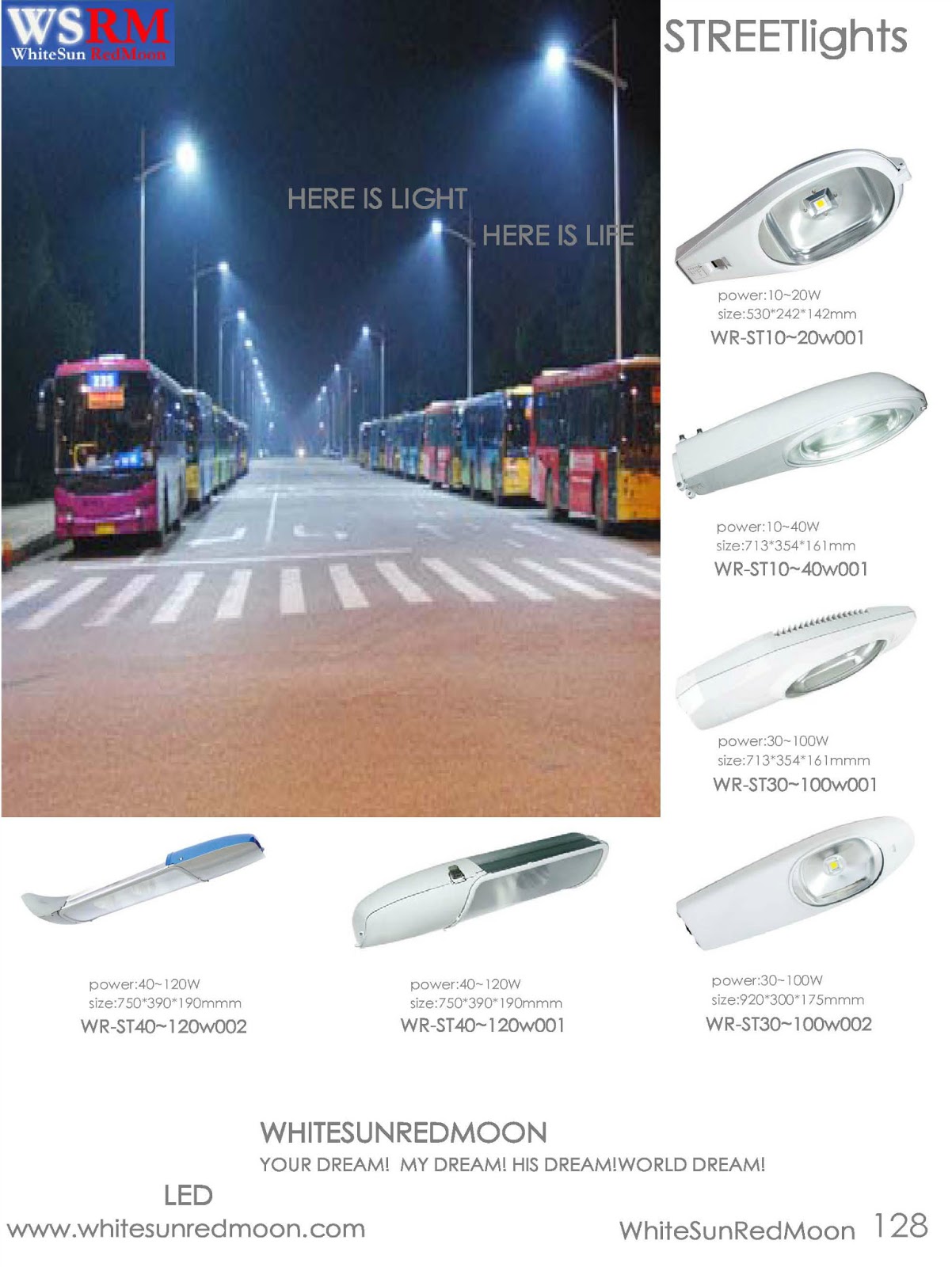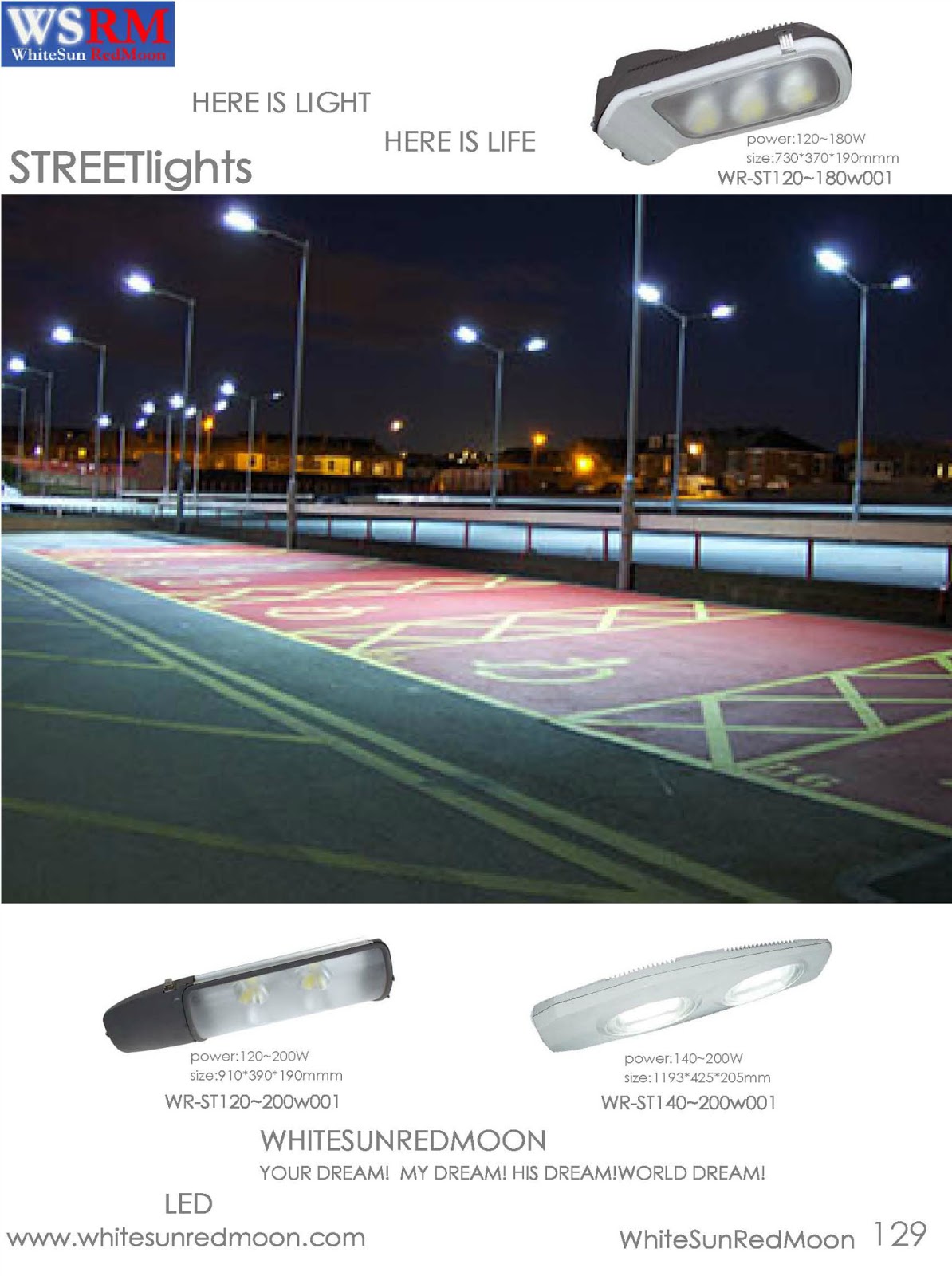WSRM---LED STREETlights with an improved efficacy and excellent light control!
As we know Street lights help keep streets safe and prevent accidents for drivers and pedestrians by marking the public roads and sidewalks of many communities. Older street lights use conventional light bulbs while more modern lights use energy-saving Light Emitting Diode (LED) technology. In both cases, street lights need to be durable enough to withstand the elements while continuing to provide light.
Street lights usually composed with three parts of Post/Bulb/Lens .Let m introduce it for u firstly.
POST(we dont provide it unless customer ask for it)
One component common to all types of street lights is the post, which rises from a base at the ground and supports the lighting element above. Street light posts contain the electrical wiring that connects the lights directly to the electric grid. Some posts also include a service door for gaining access to a street light's control unit and making repairs or adjustments from ground level.
Street lights posts need to be able to withstand ice, wind and rain. Rust-resistant metals or a protective coat of paint can help preserve the post against the elements, and metal is by far the most common material for its strength and rigidity. Some street light posts, such as those in an historic district, may be decorative, while others are simple grey shafts.
BULBS
Street light bulbs come in a wide range of styles and sizes. Most conventional street lights use halogen bulbs, which are similar in function and appearance to household incandescent bulbs. These bulbs consist of a vacuum tube with a filament inside and an inert gas (such as halogen) that causes the burned portion of the filament to recollect on the filament wire, extending the life of the bulb. Metal halide bulbs employ similar technology but use even less energy and produce more light.
Fluorescent street light bulbs are fluorescent tubes, which contain a gas that reacts to a current to create illumination. Fluorescent street lights tend to use less energy than other bulbs and cast a greenish light, while halogen bulbs cast a warmer, orange light. Finally, light-emitted diodes, or LEDs, are the most efficient type of street light bulb. LEDs are semiconductors that produce a strong illumination and last much longer than bulbs.
LED street lights include heat exchangers to regulate temperature. These devices moderate the heat that an electrical current produces as it powers the LED. Heat exchangers use the passage of air over a series of fins to keep the lighting element cool and to make sure that the LED is able to produce even light without darker areas or "hot spots" that might otherwise occur.
LENS
LED and conventional street lights feature a curved lens that is usually made of heavy-duty glass or, more commonly, plastic. Street light lenses function to magnify the effect of the light inside. They also direct the light downward toward the street for maximum efficiency. Finally, street light lenses protect the delicate lighting elements inside. Fogged, scratched or broken lenses are much easier and cost-effective to replace than entire lighting elements.
WSRM---LED STREETlights, the innovative LED series for outdoor lighting, it is possible to illuminate squares, streets, parking lots and tunnel with higher efficiency and lower cost than a traditional HID lighting system.
WSRM---LED STREETlights r A futuristic designed example A key to achieve controlled output from these high efficiency LEDs is the optical performance.WSRM---LED STREETlights “nano otpic”, a refractor that sits directly on the LED, can direct the light in a variety of light patterns (actually 8 different types of optics are available), with an improved efficacy and excellent light control.
The expected life cycle of WSRM---LED STREETlights, is up to 100.000* hours, at an average ambient temperature of 15°C. At lower temperature and when adopting two level options, the life of the product can increase even more. The secret is, once again, in a totally new approach to manage thermally WSRM---LED STREETlights. The airflow system is a new concept developed to cool down the Led by maximizing the slightest air movement to draw heat away
To give a quick comparison with standard technology, the average life cycle of an HID products is only 20.000 hours. At that time it is necessary to replace the lamp in order to maintain the fixture efficiency.
The LEDs power takes place in DC, through an electronic converter with input voltage range between 120V and 277V 50Hz/60Hz; this device ,therefore, acts as a voltage stabilizer and makes the internal DC circuit (that supplies energy to the diodes) insensitive to sudden voltage changes or to voltage variations such as those generated by a flux controller. Thus, over the LEDs there will be no change of input voltage, as the voltage in wiring varies.
The future technology:
• A clean technology: no waist and no heat generation (CE/RoHS compliance)
• Cold Technology: minimum environmental impact
• No maintenance costs: a product build to last more than 20 years without service (No relamping, Self Cleaning system)
• Energy saving: today LED is the most efficient white light source
The LED system:
• Nano reflector technology: 8 optical options
• TRS – Total Reflectivity System
• Electronic management: dimming and control
• 2 years product warranty and 10 years finish warranty
• Every LED light bar consist of HIGH power of LEDs 1W, at 350 mA, which can be combined for 10W to 200W.
SALES CONTACT
ITALY
Torino
39011redmoon1@myledonline.com
Rome
3906whitesun1@myledonline.com
SPAIN
Barcelona
3493redmoon1@myledonline.com
GERMANY
Berlin
4930whitesun1@myledonline.com
FRANCE
Paris
331redmoon1@myledonline.com
ENGLAND
London
4420whitesun1@myledonline.com
RUSSIA
Moscow
7499redmoon1@myledonline.com
FINLAND
Helsinki
3589whitesun1@myledonline.com
NORWAY
Oslo
47whitesun1@myledonline.com
AUSTRIA
Vienna
431whitesun1@myledonline.com
39011redmoon1@myledonline.com
Rome
3906whitesun1@myledonline.com
SPAIN
Barcelona
3493redmoon1@myledonline.com
GERMANY
Berlin
4930whitesun1@myledonline.com
FRANCE
Paris
331redmoon1@myledonline.com
ENGLAND
London
4420whitesun1@myledonline.com
RUSSIA
Moscow
7499redmoon1@myledonline.com
FINLAND
Helsinki
3589whitesun1@myledonline.com
NORWAY
Oslo
47whitesun1@myledonline.com
AUSTRIA
Vienna
431whitesun1@myledonline.com
NETHERLAND
Amsterdam
3120whitesun1@myledonline.com
SWITZERLAND
Zurich
4144whitesun1@myledonline.com
TURKEY
Istanbul
90216whitesun1@myledonline.com
BELGIUM
Brussels
322whitesun1@myledonline.com
SWEDEN
Stockholm
468whitesun1@myledonline.com
HUNGARY
Budapest
361whitesun1@myledonline.com
SCOTLAND
Glasgow
44141whitesun1@myledonline.com
ICELAND
Reykjavik
354whitesun1@myledonline.com
SWITZERLAND
Zurich
4144whitesun1@myledonline.com
TURKEY
Istanbul
90216whitesun1@myledonline.com
BELGIUM
Brussels
322whitesun1@myledonline.com
SWEDEN
Stockholm
468whitesun1@myledonline.com
HUNGARY
Budapest
361whitesun1@myledonline.com
SCOTLAND
Glasgow
44141whitesun1@myledonline.com
ICELAND
Reykjavik
354whitesun1@myledonline.com





No comments:
Post a Comment